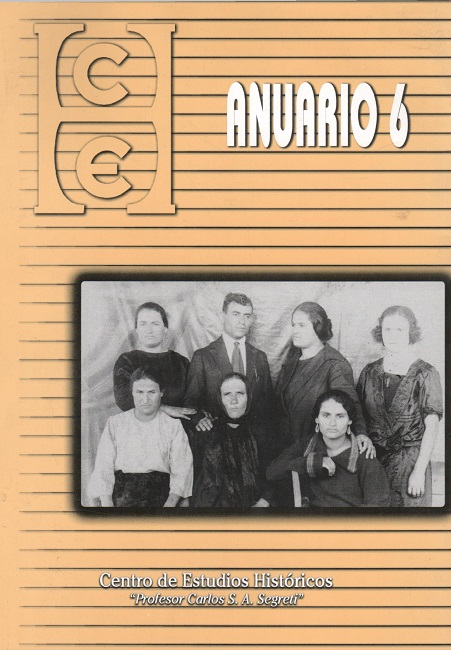Beyond regulation. National and Provincial Policies on Wine Issues, 1935-1946
DOI:
https://doi.org/10.52885/2683-9164.v.n6.23219Keywords:
wine making, regulation, consumption, publicityAbstract
The policies that were employed in Argentina in order to overcome the consequences of the 1930 crisis were made operative, in the case of agrarian and agro-industrial activities, through production and commerce public regulation. The office that was created relative to wine production was the Wine Regulation Board, which started to function in 1935. As the regulations coming from the aforementioned national office were put into practice, local authorities and private enterprises also made use of various practices intended to diminish the nastiest effects of the crisis and to relocate the agro industry both in the local and national market. This paper intends to perform and study of the assemblage of those policies, which included advertisement campaigns in favor of the consumption of national wine, advice on improving wines quality various attempts at rationalizing the production method; as well as the creation of a "mythology" associated to the growing of grape and the elaboration of wine, with the establishment of the "Fiesta de la Vendimia". The consumer market, the organization of the production and the development of consensus were the areas of activity of both businessmen and public servants.
Downloads
References
BELEJ Cecilia, MARTIN A. L, SILVEIRA A, “La más bella de los viñedos. Trabajo y producción en los festejos mendocinos (1936-1955)”, LOBATO Mirta Z., (ed.), Cuando las mujeres reinaban, Buenos Aires, Biblos, 2005.
GIRBAL-BLACHA Noemí, Ajustes de una economía regional. Inserción de la vitivinicultura cuyana en la Argentina agroexportadora, 1885-1914”, Investigaciones y Ensayos, núm. 35, 1987.
GIRBAL-BLACA Noemí, OSPITAL María Silvia, “El caso de la vitivinicultura cuyana”, GIRBAL-BLACHA Noemí, OSPITAL María Silvia, ZARRILLI Adrián G, Las miradas diversas del pasado. Las economías agrarias del interior ante la crisis de 1930, Buenos Aires, Edición Nacional, Edit., e Impresora, 2005.
GIRBAL-BLACHA Noemí y OSPITAL María Silvia, “Vivir con lo nuestro”, Publicidad y agroindustrias en la década del 30. Otra forma de hacer política”, Revista Europea de Estudios Latinoamericanos núm. 78, abril 2005.
HOBSBAWM Eric y RANGER Terence, La invención de la tradición, Cambridge University, Cambridge, 1989.
MARTIN José, Políticas estatales y conformación de una burguesía industrial regional, Mendoza, EDIUNC, 1992.
MATEU Ana, “Bancos, créditos y desarrollo vitivinícola”, Cuadernos de Historia Regional, Universidad Nacional de Luján, núm. 17, 1994.
MATEU Ana María, “La vitivinicultura mendocina en los años treinta: entre el derrame de vinos y la profusión de estudios sobre la crisis”, ponencia en el I Congreso de Historia Vitivinícola Regional, Montevideo, Noviembre de 2005, CD Rom.
RICHARD Rodolfo, “El mercado de trabajo vitivinícola en la provincia de Mendoza y los nuevos actores”, Revista Interdisciplinaria de Estudios Agrarios, Buenos Aires, núm. 18, primer semestre 2003.
RICHARD Rodolfo, Poder, economía y espacio en Mendoza 1850-1900, Universidad Nacional de Luján, núm. 17, 1994.
SUPPLEE Joan Ellen, Provincial Elites and the Economic Transformation of Mendoza, Argentina. 1880-1914, University of Texas at Austin, Ph. D, Diss, 1998.
Downloads
Published
Issue
Section
License
Aquellos autores/as que tengan publicaciones con esta revista, aceptan los términos siguientes:
- Los autores/as conservarán sus derechos de autor y garantizarán a la revista el derecho de primera publicación de su obra, el cuál estará simultáneamente sujeto a una Licencia de reconocimiento de Creative Commons. Se puede compartir, copiar, distribuir, ejecutar y comunicar públicamente la obra, siempre que: a) se cite la autoría y la fuente original de su publicación (revista, editorial y URL de la obra); b) no se use para fines comerciales; c) no se altere, transforme o genere una obra derivada a partir de esta obra.
- Los autores/as podrán adoptar otros acuerdos de licencia no exclusiva de distribución de la versión de la obra publicada (p. ej.: depositarla en un archivo telemático institucional o publicarla en un volumen monográfico) siempre que se indique la publicación inicial en esta revista.
- Se permite y recomienda a los autores/as difundir su obra a través de Internet (p. ej.: en archivos telemáticos institucionales o en su página web) después del proceso de publicación, lo cual puede producir intercambios interesantes y aumentar las citas de la obra publicada. (Véase El efecto del acceso abierto).









